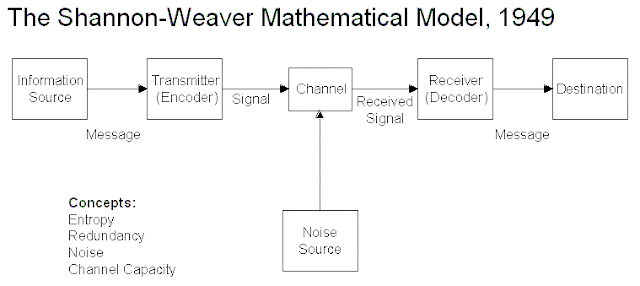Shannon & Weaver were asked by the US military 'how can we make our telecommunication more effective' What they created was a 5 step process;
- Information source- Receive the brief, the problem
- Transmitter- Concept, visual ideas
- Channel- The production stage
- Receiver- Format, distribution
- Destination- Audience communication.
From this we were asked to discuss what problems could arise during each step;
- Information source- Poor communication with the client, vague description/brief. Bad briefing.
- Transmitter- Poorly informed design concepts, terrible concepts. Misinterpretation of the concepts. Could just be a very bad designer or not considered the audience
- Channel- Production issues, cost implements, context of production. Could have designed an amazing ad but wrong location or advertised at the wrong time.
- Receiver- Misinterpretation, offensive, language barrier, tone of voice.
- Destination- Lack of feedback, linear (goes straight from A-B, no feedback stage) authoritarian model, flawed messages.
Based on these problems how could we resolve them?
- Information source- Question brief to fully grasp it, pre prep and consult.
- Transmitter- Thorough research, practice, experiment, constant feedback to refine.
- Channel- Plan in advance, consider possible limitations before hand and factor them into the design
- Receiver- Constant feedback
- Destination- Again constant feedback
Noise sources is anything that interferes the process of communication, but social and visual forms of noise get in the way of communication. Forms of noise that could interfere with the design process are;
- Information source- Noise from bureaucrats interfering with budgets and decisions, poor company ethics could interfere.
- Transmitter- Personal style not fitting the brief, interfering clients and distractions.
- Channel- Technological issues.
- Receiver- Destination/location, colour blindness, illiterate, distracting competition.
- Destination- Belittlement, sub culture, opinion and prejudices.
Communication problems
There are 3 levels of communication problems-
- Technical problems- how accurate can the message be transmitted?
- Semantic problems- how precisely is the message conveyed?
- Effectiveness- how effectively does the received meaning affect the behaviour?
- Technical problems- Broken equipment, skills.
- Semantic problems- Misinterpretation, misunderstanding, wrong tone of voice, poor colour scheme. All things that relate to visual.
- Effectiveness- Feedback or lack of it, location.
Zines are a form of noise in the visual communication world, they're produced on a limited budget, poor quality, production and use slang. However this isn't always a negative, there is noise aesthetic created from this, all graffiti aims to be noise. Noise can be the outcome or design, it can be a problem or a solution.
Redundancy VS Entropy
Redundant- it doesn't refer to the term used to mean not needed, redundant means it provides no resistance to the communication lines, smooth communication.
Entropy- communication changes into something entirely different and unexpected.
The world depends on redundant communication because it is something really successful solely because the content is low and understandable. There isn't a lot that can go wrong with it, it communicates to a wide audience, highly predictable and low information. Whereas something entropic has low predictability, it's complex, open to wide variety of meaning, unconventional and highly informative. Generally targets a niche.
Graphic design for a mass audience is highly redundant making it conservative. Highly entropic design is shocking, thought provocative, loss of communication for shock making it stand out. Both are used in different contexts.
Redundant taps into existing sources and conventions instead of forcing the status quo, it trades on assumptions that already exist in society.
The world depends on redundant communication because it is something really successful solely because the content is low and understandable. There isn't a lot that can go wrong with it, it communicates to a wide audience, highly predictable and low information. Whereas something entropic has low predictability, it's complex, open to wide variety of meaning, unconventional and highly informative. Generally targets a niche.
Graphic design for a mass audience is highly redundant making it conservative. Highly entropic design is shocking, thought provocative, loss of communication for shock making it stand out. Both are used in different contexts.
Redundant taps into existing sources and conventions instead of forcing the status quo, it trades on assumptions that already exist in society.
